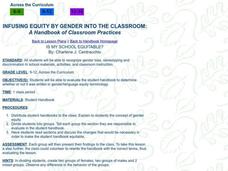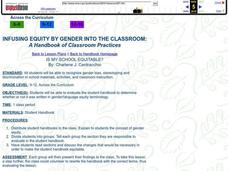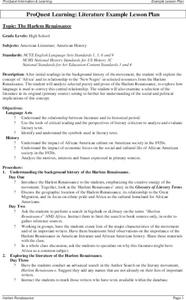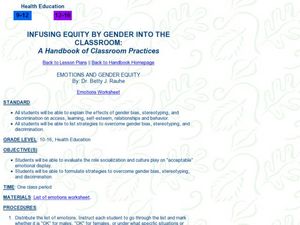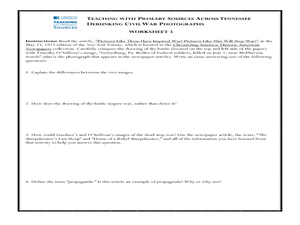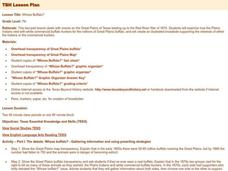Curated OER
Determining Point of View
Students examine web sites to determine point of view and bias in information sources. They determine the usefulness of information based on these biases or limitations.
Curated OER
IS MY SCHOOL EQUITABLE?
Students evaluate student handbooks and determine if it is gender bias.
Curated OER
Using Picture Books to Teach the Holocaust
Students compare a photo of a child's room during the Holocaust to their room. In this WWII lesson, students read picture books and evaluate the roles of characters in the book. Students create either a poster about the roles, a movie...
Curated OER
LIFE DOESN’T FRIGHTEN ME
Students examine gender bias and stereotypes. For this discrimination lesson students participate in class discussions and poetry reading in order to examine the gender stereotypes of fears and develop the...
Curated OER
Discrimination on the Menu
Students study discrimination in the workplace. In this discrimination lesson, students define the term 'fair' and work in groups to find ways all people are alike and different. Students write sentences defining a fair classroom, a fair...
Curated OER
IS MY SCHOOL EQUITABLE?
Students analyze the students handbook and revise each section to make it equitable for males and females. In this stereotypes instructional activity students engage in a discussion of gender inequality and then look through the student...
Curated OER
What Influences Our Perception of Gender Roles?
Students research gender equity and the media. In this gender equity instructional activity, students evaluate the influence of various media on both individuals and society. Students discuss examples of media that portray...
Crabtree Publishing
Why Does Media Literacy Matter?
Criticism of news and entertainment journalism is at an all-time high. Help 21st-century learners develop the media literacy skills they need to become critical consumers with a three-lesson guide the looks at persuasive techniques used...
Curated OER
Propaganda: Making a Commercial
Seventh graders study different propaganda techniques. In groups, they write and perform a 60-second TV or radio commercial. Classmates rate the effectiveness of the commercial and whether or not they might buy the product.
Curated OER
The Lion and the Mouse
Students write a story. In this critical thinking and writing lesson, students read a fable, answer the provided thinking skills questions, and write their own fable.
Curated OER
The Harlem Renaissance
Students, after researching/analyzing the movement "Harlem Renaissance" and Africa as well as reading literature from that time period, create lists of the major characteristics of the movement and its important writers. They bridge the...
Curated OER
Lincoln's Legend and Legacy
Students evaluate Lincoln's impact on American History. In this Civil War lesson, students view a film clip of writings about Lincoln. Students take notes and compare how the writings define his legacy. Students write their own poem or...
Curated OER
Critiquing A Speech Contestant
What makes a speech effective? Middle schoolers critique a speech for content and presentation. They view a video of a middle school student presenting an informational speech, They outline the content of the speech and critique the...
Curated OER
DETERMINING THE EXISTENCE OF GENDER BIAS IN DAILY TASKS
Young scholars identify task assignments by gender.
Curated OER
Infusing Equity by Gender Into the Classroom: A Handbook of Classroom Practices
Young scholars match their natural proclivities to possible future careers which are nontraditional for their genders. They further examine gender stereotypes through other activities.
Curated OER
INVESTIGATING NONTRADITIONAL OCCUPATIONS
Students identify careers that are nontraditional for their gender. In this occupations lesson students research careers that are nontraditional for their gender and conduct interviews with individuals employed in nontraditional...
Curated OER
Without Limits
Seventh graders research about the important contributions of two scientists they chose from the list. In this science lesson, 7th graders develop a creative presentation such as skits or news program about their research. They present...
Curated OER
How Are We Different?
Students discuss the differences between boys and girls. In this acceptance instructional activity, students view pictures of boys and girls and use a Venn Diagram to chart their differences. Students discuss boy activities...
Curated OER
Teaching with Primary Sources Across Tennessee: Debunking Civil War Photographs
Students analyze photographs and texts using primary source analysis. In this primary source lesson students determine whether the photographs and text are truthful.
Curated OER
Students Press Law and Ethics
Students research the rights and the responsibilities of journalists in dealing with First Amendment issues. In this First Amendment lesson plan, students research the Alien and Sedition Acts and study the five elements of...
Curated OER
Your Angle on the Story
Students review several articles on same current event, and then cover news issues themselves while assuming secret identities of various individuals who have vested interests in issue. Students write newspaper articles from these...
Curated OER
Anne Frank: The Island of the Skog
Students read and discuss The Island of the Skog by Steven Kellogg and examine the illustrations, keep a "discrimination log," and write about one example of discrimination and how they could have intervened to stop it.
Curated OER
Whose Buffalo?
Seventh graders examine how the Plains Indians vied with white commercial buffalo hunters for the millions of Great Plains buffalo. They create an illustrated broadside supporting the interests of either the Indians or the commercial...
Curated OER
To Kill a Mockingbird
Students explore the components of racismas they read through Horton Foote's, "To Kill a Mockingbird." The trial of the main character reveals instances of justice in the face of prejudice and forms the focus of the lesson.



